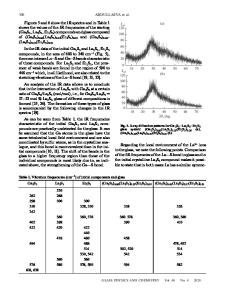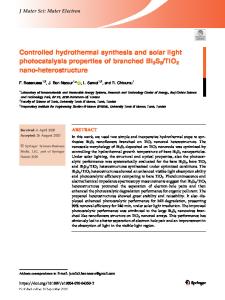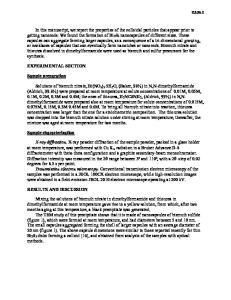Hydrothermal synthesis of Co-doped In 2 S 3 micropompons and their physical properties
- PDF / 774,632 Bytes
- 7 Pages / 585 x 783 pts Page_size
- 69 Downloads / 535 Views
In2−xCoxS3 (x ⳱ 0 to 0.1) micropompons (diameters ∼3–4 m) consisting of ∼10–15-nm-thick randomly self-assembled nanoflakes were synthesized hydrothermally. X-ray study indicated a steady variation of lattice parameter ratio up to 5% Co. Detailed investigations of the Co incorporation in In2S3 were carried out by optical absorbance, room temperature photoluminescence (PL), and electron paramagnetic resonance (EPR) studies. Significant blue shift in the absorbance spectra was noticed due to the crystal-field splitting of Co2+ ions in the host lattice structure. Unlike the visible emission found in undoped In2S3, PL spectra of the Co-doped samples were recognized by a strong ultraviolet emission peak at ∼335 nm, introduced by the t2g level of Co2+ ions, with maximum intensity for 5% Co. Room-temperature and low-temperature EPR spectra revealed octet paramagnetic bands up to 5% Co beyond which a single resonance band appeared.
I. INTRODUCTION
For the last five decades, transition metal ion-doped semiconductors have been of central importance from both the physical and technical points of view.1,2 In particular, transition metal ions substituting for the group II or III element in the corresponding II–VI or III–VI compound semiconductors impart a local spin due to their half-filled d-shells and donate carriers to the system that imparts magnetism in an otherwise nonmagnetic material. The interest in these materials is related to their potential application in spintronic devices due to the ability to control the degrees of freedom of both spin and charge by monitoring the free ion concentration.3,4 Moreover, transition metal ions such as Cr, Co, and Fe, are reported to exhibit broad absorption and emission bands with large oscillator strengths.4 As for nanostructures, an additional advantage is that their magnetic properties are mostly enhanced from that of the bulk counterparts. Tetragonal indium sulfide (In2S3) is an important n-type III-VI semiconductor, which because of its defect structure, shows many noticeable optoelectronic,5–7 photoconductive,8 and optical properties.9,10 In2S3 also has a large number of vacancies [In6(In2□)S12; □ represents vacant sites] in the crystal structure that can largely act as a reservoir for ions intentionally implanted as dopants.
a)
Address all correspondence to this author. e-mail: [email protected] DOI: 10.1557/JMR.2008.0113 J. Mater. Res., Vol. 23, No. 4, Apr 2008
http://journals.cambridge.org
Downloaded: 02 Mar 2015
Under certain conditions, a high degree of vacancy ordering can take place at tetrahedral cation sites by these dopant ions that can otherwise show enhanced physical properties. In our earlier work on undoped In2S3 micropompons, the interesting finding was the formation of micropompon-like structures by the assembly of very thin flakes ∼10–15 nm wide, which showed excellent optical properties.11 Herein, Co-doped In2S3 micropompons have been prepared by a similar hydrothermal process. Co is a common magnetic dopant, which has been reported to impart many i
Data Loading...











